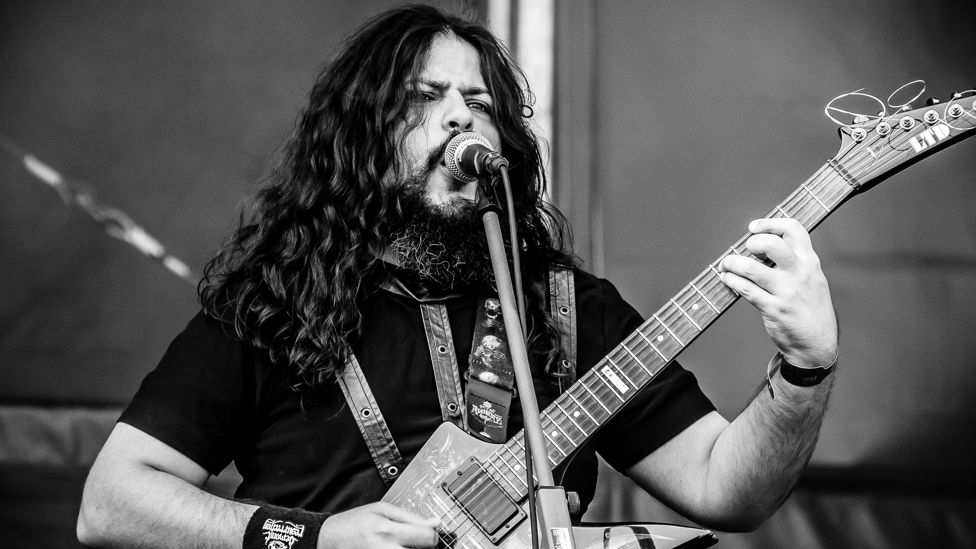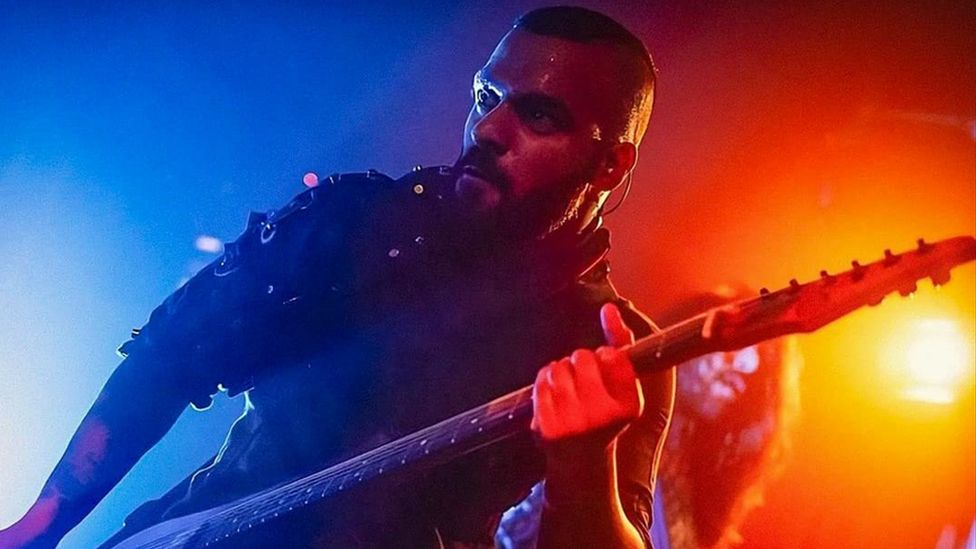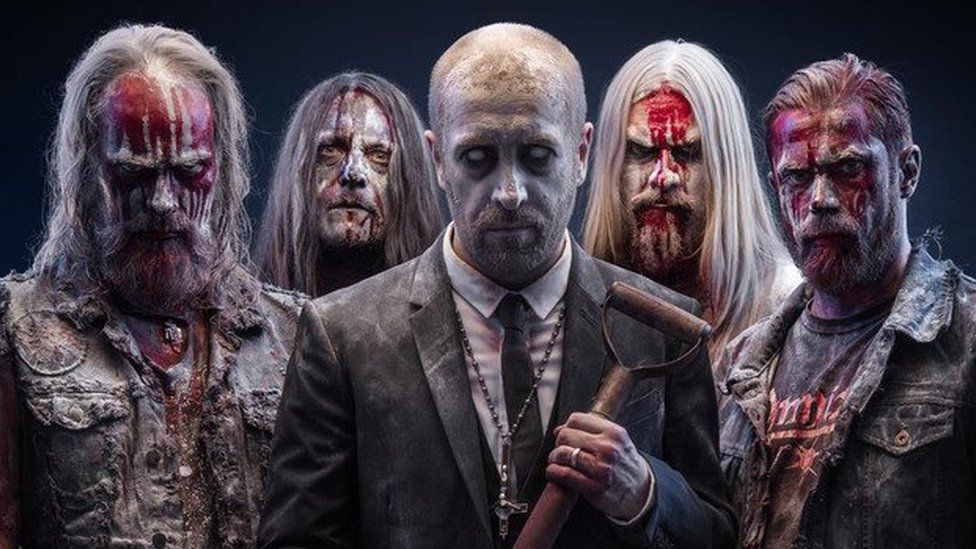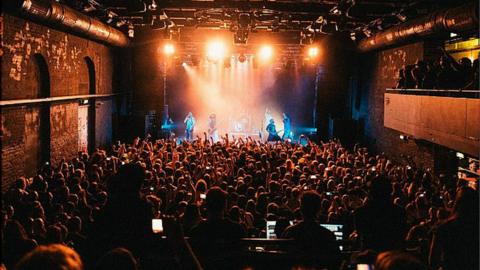This video can not be played
To play this video you need to enable JavaScript in your browser.
“Make metal great again.”
That’s what Bloodywood, a four-member metal band based in India’s capital Delhi, wanted to do when they first began making music in 2016.
Bloodywood began their journey as a “parody band”, uploading metal covers of popular Hindi songs on YouTube. Six years on, they have toured about 90 countries, played in some of the most iconic venues – including Wacken Open Air – and have become the first Indian metal act to feature on Billboard charts.
The band’s music is strictly headbanging – but it’s their ability to introduce folksy sounds and textures into the classic chug of heavy metal that sets them apart. A gorgeous flute crescendo pulls you in a trance before an unexpected blast of dhol (a percussion instrument), followed by a gnarly riff, shatters you out of it. Rolling Stone magazine describes their concerts as “an aural assault”, and fans call it a “violent sensory overload”.
The band has also made waves in India, where it headlined several big music festivals this year, including Lollapalooza, and Nh-7 Weekender. Their popularity has sparked hopes of reviving metal in a country where the genre still features on very few playlists.
“We played on some of the biggest stages in the world but home hits different – it’s where we want to grow,” says Raoul Kerr, the band’s vocalist.

India’s metal scene dates back to the 1980s when heavy metal bands like Millennium broke on the scene. While rock jazz quickly found new listeners, metal continued to be seen as an “underground movement”, existing on the fringes of the mainstream. Listeners were few, record labels were hard to come by and touring mostly meant performing in college festivals.
But despite the limitations, listeners say it was always a vibrant community.
The hole-in-the-wall venues were bursting with energy. The audience, although categorised as niche, were a loyal bunch. The concerts were attended mostly by students who – sporting their goat-like beards, devil-horn gestures and black metal t-shirts – headbanged through the night.
“You had to be there to exactly understand how the scene rocked back in the day,” says Sahil Makhija from Demonic Resurrection, a heavy metal band founded in 2000 and often credited with popularising metal in the country.
Much has changed since. Bands were disbanded as lack of venues, income and audiences pushed them to obscurity. Over the years, a lot of metalheads from Makhija’s generation also got other jobs and “ended up living completely different” lives.
“Suddenly, our favourite black metal shirt was relegated to a corner of the wardrobe,” he says.

A resurgence of sorts happened in the late 2000s when internet and social media opened a whole new world of opportunities. In 2011, when American metal band Metallica performed in Bengaluru (formerly Bangalore) city, over 50,000 metalheads from all over the country attended the concert and spotlighted the genre’s presence like never before.
More than a decade on, metal’s integration into the cultural mainstream seems somewhat complete.
International legends, including Megadeth and Karnivool, tour the country. And Indian acts like Bloodywood now play for an audience that includes a fresh crop of young, first-time listeners. “At every concert, we see new faces. Sometimes, people show up with their entire families,” says band vocalist Jayant Badhula.
Makhija says the scene has benefitted a lot from India’s burgeoning concert culture. “People associate metal with aggression, but the energy at a metal gig is infectious and just watching an act live can completely alter opinions.”
Bands like Bloodywood have also pushed their music to newer directions that have changed the way people understand metal.
Metal has long moved away from the notion of being an “apolitical” counterculture of rebellious music. From war to corruption to government failures, bands like Black Sabbath and Nuclear Assault – to name a few – have tackled socio-political subjects through their songs for decades. However, the genre’s casual reference to violence and controversial themes like Satanism or cannibalism continue to make listeners uncomfortable.
Sporting beards, a map of tattoos and waist-length hair, folks at Bloodywood certainly give off that energy. But their music is more meditative than violent.
The demons in their songs aren’t real. Instead, they are resounding metaphors reflective of the societal ills that plague our world. The band roars against sexism, religious violence and political corruption in anthems that guide you through both darkness and light.
“I think there is a bit of metal in all of us. Our goal is to channel that angst for the right causes and make people want to do something about them,” says Kerr.

But while Bloodywood’s success is a cause of celebration, many fans say the scene in India is still far from perfect.
“Apart from Bloodywood, no other Indian metal band is still performing at a grand scale,” says Deep Bhattacharya, a Delhi resident.
Growing up in the capital in the late 2000s, Mr Bhattacharya has fond memories of attending metal gigs at homegrown cafes.
But he says the consumption of metal dropped considerably, forcing some of the favourite acts on the scene – such as Scribe and Makhija’s Demonic Resurrection – to stop making music. “The popularity for international artistes has grown, but Indian bands have reached a dead end. People just don’t want to spend money to watch them.”
Mr Bhattacharya adds that Bloodywood was able to overcome this problem only because they managed to tap into a vast international audience. The band first grabbed eyeballs in 2019 during their debut tour to Europe. But it took them another six years to perform in their own country.
The band agrees with the assessment. “From the start, we knew we had to make it big globally before we would get a chance to do it in India. Metal here is a tight-knit passionate community, but there aren’t a lot of us,” Kerr says.
Makhija says the seeming vacuum has something to do with the genre itself.
Over the years, metal has metastasized into many subgenres that are constantly finding new takers and earning genuine praise. But it is still not the biggest selling genre anywhere in the world. “When you compare it to pop music, metal is still an underground subculture. The difference is even more stark in India where only a handful of urban listeners consume the genre,” Makhija says.
But that also does not mean the scene is over.
“Metal is alive in India,” Makhija says. “There are children doing what we did 20 years ago.”
Additional reporting by Bimal Thankachan

Read more India stories from the BBC:

-
-
31 December 2012
.jpg)
-
-
-
13 March 2019

-

